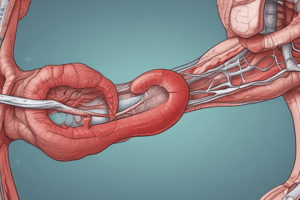Podcast
Questions and Answers
What is the normal location of the point of maximum impulse (PMI) in adults?
What is the normal location of the point of maximum impulse (PMI) in adults?
- In the 5th intercostal space medial to the midclavicular line (correct)
- In the 6th intercostal space at the midclavicular line
- In the 4th intercostal space at the midclavicular line
- In the 5th intercostal space at the midclavicular line
What is the normal diameter of the PMI in adults?
What is the normal diameter of the PMI in adults?
- 1 to 2 cm (correct)
- 2 to 3 cm
- Less than 1 cm
- Greater than 3 cm
What does a displaced or enlarged PMI indicate?
What does a displaced or enlarged PMI indicate?
- Enlarged or aneurysmal heart (correct)
- Decreased left ventricular function
- Decreased blood flow through the aorta
- Normal heart size
What is the normal finding for abdominal aortic pulsations?
What is the normal finding for abdominal aortic pulsations?
What is the purpose of the diastolic phase of the cardiac cycle?
What is the purpose of the diastolic phase of the cardiac cycle?
What is the normal finding for the second heart sound (S2) during auscultation?
What is the normal finding for the second heart sound (S2) during auscultation?
What is the recommended position for the client to be in while assessing the carotid arteries?
What is the recommended position for the client to be in while assessing the carotid arteries?
Which of the following is a normal finding when palpating the carotid arteries?
Which of the following is a normal finding when palpating the carotid arteries?
What may increased pulsation in the carotid arteries indicate?
What may increased pulsation in the carotid arteries indicate?
What should be done to test for calf tenderness?
What should be done to test for calf tenderness?
How should the client's leg be positioned during Homan's test to check for tenderness?
How should the client's leg be positioned during Homan's test to check for tenderness?
'Swelling on one calf or leg' is listed as a deviation in assessing which area?
'Swelling on one calf or leg' is listed as a deviation in assessing which area?
What is the function of the Hepatic Portal Veins?
What is the function of the Hepatic Portal Veins?
Where do Renal Veins drain deoxygenated blood from?
Where do Renal Veins drain deoxygenated blood from?
Where is the Femoral Vein located?
Where is the Femoral Vein located?
What should be assessed in peripheral leg veins for signs of phlebitis?
What should be assessed in peripheral leg veins for signs of phlebitis?
What should be assessed in the areola according to the text?
What should be assessed in the areola according to the text?
What should be inspected in the nipple according to the text?
What should be inspected in the nipple according to the text?
Which position is recommended for clients with pendulous breasts during a breast examination?
Which position is recommended for clients with pendulous breasts during a breast examination?
When palpating the breasts, which action should be taken if the client reports a breast lump?
When palpating the breasts, which action should be taken if the client reports a breast lump?
Which of the following techniques should be used to enhance breast flattening during palpation?
Which of the following techniques should be used to enhance breast flattening during palpation?
Which of the following should be assessed when evaluating any nipple discharge?
Which of the following should be assessed when evaluating any nipple discharge?
What is considered a normal finding during a breast examination?
What is considered a normal finding during a breast examination?
Which of the following statements regarding breast development in children is true?
Which of the following statements regarding breast development in children is true?
What is the Tanner stage characterized by the projection of the areola and nipple?
What is the Tanner stage characterized by the projection of the areola and nipple?
During early adolescence, what change might boys experience in their breast area?
During early adolescence, what change might boys experience in their breast area?
In what Tanner stage do axillary hair usually appear?
In what Tanner stage do axillary hair usually appear?
What is a characteristic change in pregnant females' nipples?
What is a characteristic change in pregnant females' nipples?
What change occurs in older adults' breasts postmenopause?
What change occurs in older adults' breasts postmenopause?
What is a typical change observed in pregnant females' breasts besides increased size?
What is a typical change observed in pregnant females' breasts besides increased size?
Flashcards are hidden until you start studying




